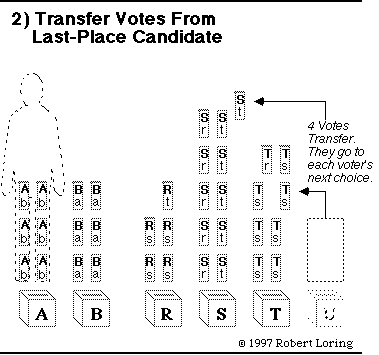|
Different uses for voting
need different types of voting. |
 |
Single Transferable Vote |

|

|
You might want to read the pages on single-winner STV and party-list Proportional Representation before reading this page on multi-winner Single Transferable Vote. How can we give more voters the power to nominate candidates? Here is an analogy: Each candidate puts out a box. A voter puts his ballot in his favorite candidate's box. The ballots are counted. If the box gets enough ballots, it wins. If not, the voter moves his ballot to another candidate's box. Or, he waits, hoping others will move their ballots to his favorite box. To break that deadlock, we have a rule: If a round of counting ballots finds no winner, the box with the fewest votes is eliminated. Its ballots go to each voter's backup (2nd) choice – probably someone with similar views and more popularity. These transfers make voters condense into large groups supporting strong candidates. Ballots are counted again to see if any candidate gets a winning share of the current top ranks. When half of all ballots are in 1 candidate’s box, she wins a single-seat STV election. In the UK that is called the Alternative Vote, and Australians call it Preferential Voting. In the USA, it's called Instant Runoff Voting, which is one type of Ranked-Choice Voting. A box needs less than half the ballots to win a seat on a council. To win 1 of 5 seats requires the top rank on only one-fifth of the ballots or 20%.[1] An interest group with 20% of the voters will win 1 seat after moving their ballots, no matter how many extra candidates they start with. A group with 60% of the voters will win 3 seats and only 3. That is their fair share and their Proportional Representation (PR). If a candidate gets more than enough votes, a share of the extra votes goes to each supporter's next choice. In practice, each voter ranks the candidates as 1st choice, 2nd choice, 3rd etc. Then officials move ballots between boxes or a computer tallies them. [1] footnote: The winning threshold most often used to elect five reps is one-sixth plus one vote. No more than five candidates can gather that many votes. Tideman and Richardson (2000) explain the development of STV including the newest versions. |
STV is explained best through pictures on linked pages. To play the game, click the pile of ballots that must transfer. A correct click jumps to the next step of the tally. (If you don't like to play, you can just page down to the next step.)
STV protecting rights of the majority
|
Merits of STV: PR and PartiesThe most widely-used form of Proportional Representation is called party-list PR. In many places, its ballots give voters only a choice of parties, not of candidates. A party gets a share of seats equal to its share of votes. The first name on a party's list of nominees gets the first seat her party wins. Party leaders usually write the list, so they have immense power over junior politicians and voters. As a result, public, intra-party debate is rare under List PR, which is used in most European countries.To spread power and broaden the appeal of its list, a party convention could use STV to elect the nominating committee — whose members take turns adding names to the list. (This can help a club or church offer members a diverse slate of “official” nominees.) A great advantage of STV is that it needs no parties. That means it can be used by organizations which haven't any, such as unions, clubs, and schools. Many British and Australian Universities use STV. U.S. colleges with STV include: Harvard, MIT, Oberlin, Princeton, UC Berkeley, UC Davis, Vassar, and Whitman. In 2010, Iceland used STV to elect a nonpartisan constitutional assembly. Where parties do exist, STV voters are not constrained by them. They may ignore party labels and mix nominees together, ranking a Blue party candidate 1st, an Orange 2nd, another Blue 3rd, and an independent 4th. Because it does not need parties, STV is the basis for proportional, Fair‑share Spending. The unique chapter on voting for projects will show how transferable votes are being used to select which proposals win funding. Most people want PR when they taste its benefits. So the voting workshop teaches transferable votes by voting for treats! Voting is easy. Sorting ballots for a big STV election was hard, but free software now makes an STV tally easy for any group. Programs to tally STV are available on the Tool page. The next page graphically shows how an STV tally works to protect the majority's right to a majority of seats; the page after that shows how STV works at the same time to protect the rights of a large political minority. (1) STV stands for Single Transferable Vote. STV means Single Transferable Vote. Many people in the USA prefer the term “Choice Voting” which is one kind of “Ranked-Choice Voting”. Australians call it the “Hare–Clark Proportional” method, Voters in some countries call it “Preference Voting” or “Preferential Voting”. |

|
 |



 Accurate Democracy
Accurate Democracy 







